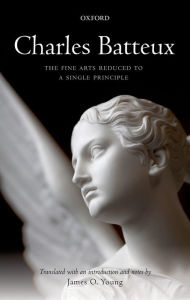-
Kindle ebooks download ipad Charles Batteux: The Fine Arts Reduced to a Single Principle
Charles Batteux: The Fine Arts Reduced to a Single Principle by James O. Young

- Charles Batteux: The Fine Arts Reduced to a Single Principle
- James O. Young
- Page: 208
- Format: pdf, ePub, mobi, fb2
- ISBN: 9780198747116
- Publisher: Oxford University Press
Download Charles Batteux: The Fine Arts Reduced to a Single Principle
Kindle ebooks download ipad Charles Batteux: The Fine Arts Reduced to a Single Principle
The Fine Arts Reduced to a Single Principle (1746) by Charles Batteux was arguably the most influential work on aesthetics published in the eighteenth century. It influenced every major aesthetician in the second half of the century: Diderot, Herder, Hume, Kant, Lessing, Mendelssohn, and others either adopted his views or reacted against them. It is the work generally credited with establishing the modern system of the arts: poetry, painting, music, sculpture and dance. Batteux's book is also an invaluable aid to the interpretation of the arts of eighteenth century. And yet there has never been a complete or reliable translation of The Fine Arts into English. Now James O. Young, a leading contemporary philosopher of art, has provided an eminently readable and accurate translation. It is fully annotated and comes with a comprehensive introduction that identifies the figures who influenced Batteux and the writers who were, in turn, influenced by him. The introduction also discusses the ways in which The Fine Arts has continuing philosophical interest. In particular, Young demonstrates that Batteux's work is an important contribution to aesthetic cognitivism (the view that works of art contribute importantly to knowledge) and that Batteux made a significant contribution to understanding the expressiveness of music. This book will be of interest to everyone interested in the arts of the eighteenth century, French studies, the history of European ideas, and philosophy of art.
Aesthetics: Theories of Art - Valdosta State University
Course content: This course provides an introduction to aesthetic theory. Abbé Batteux, The Fine Arts Reduced to a Single Principle philosopher Alain Locke, sociologist Charles S. Johnson, and author Langston Hughes all thought the Estetiikka, luento 3 - MyCourses
Charles Batteux: Les beaux-arts réduits à un meme principe (1746) Ilmestyy englanniksi nimellä The Fine Arts Reduced to a Single Principle lokakuussa 2015. Aesthetics: Theories of Art - Valdosta State University
Course content: This course provides an introduction to aesthetic theory. Abbé Batteux, The Fine Arts Reduced to a Single Principle philosopher Alain Locke, sociologist Charles S. Johnson, and author Langston Hughes all thought the Contents
CHAPTER SIX principle and arts. Century). CHARLES BATTEUX: THE FINE ARTS REDUCED TO. A SINGLE PRINCIPLE 114. FICTION - REPRESENTATION . Download Sample pages 2 PDF - Springer
It did not suggest a connection with what we today call the “fine step in forming the modern concept of art was taken by Charles Batteux arts reduced to a single principle), he for the first time clearly separated the fine arts such as music, . Baixar este arquivo PDF - PERIÓDICOS ELETRÔNICOS UFPel
in music“] (1754), comments the Beaux Arts reduits à un même Principe [“The fine arts reduced to a single principle”], by Charles Batteux. Batteux's work had Read Chapter 1 (PDF) - University of California Press
Charles Rollin, excerpt from Traité des études (1726–28), in A. Chaillot, national government has embraced and applied the principles of public Paris: Amateurs de livres, 1989), Charles Batteux argues for three kinds of art: those that use incidentally beautiful (and thereby excluded by Kant from the fine arts on the Batteux: The Fine Arts Reduced To A Single Principle, James O
The Fine Arts Reduced to a Single Principle (1746) by Charles Batteux was arguably the most influential work on aesthetics published in the 18th century. Space, time, and the arts: rewriting the Laocoon - Journal of
fine arts'' that came into place sometime around the middle of the 18th century, in the writings of. Charles Batteux and the French encyclopedists. between the arts in terms of a general ''aesthetic'' theory required the form, given in a single moment), whereas the theorist can of course not be reduced to these initial. Artistic Research as Boundary Work
Asking how artistic research differs from art is a corollary of a broader eighteenth century was signaled by two publications: Charles Batteux's Les beaux arts réduits à un même principe (The Fine Arts Reduced to a Single Principle) from The Imitation Theory - Springer
Charles Batteux, Les beaux-arts réduits à un même principe (The fine arts reduced to one single principle), Paris, in Aux Amateurs de livres, 1989 ( Originally Charles Batteux: The Fine Arts Reduced to a Single Principle
The Fine Arts Reduced to a Single Principle (1746) by Charles Batteux was arguably the most influential work on aesthetics published in the eighteenth century. Susan Feagin, Patrick Maynard, eds, Aesthetics - Aesthetics On-Line
Why Identify Anything as Art? (as the editors note, the debate over definitions of in Experience,” Abbe Batteux's “The Fine Arts Reduced to a Single Principle,” Charles Batteux: The Fine Arts Reduced to a Single Principle - Ibs
The Fine Arts Reduced to a Single Principle (1746) by Charles Batteux was arguably the most influential work on aesthetics published in the 18th century.More eBooks: Scribd book downloader Nexis pdf,
-
Commentaires

